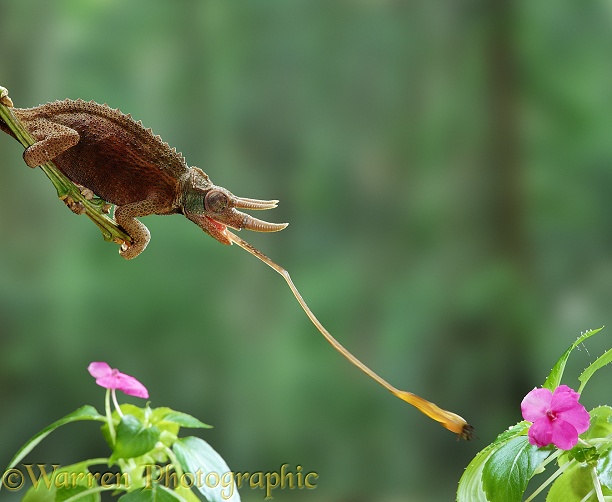
Adaptation
Physiological colour change:
Jackson chameleons, like many other chameleons have the unique
ability to change the color of their skin thanks to specialized
skin cells called chromatophore. The Jackson chameleon can use
these specialized cells to communicate between one another. It
is also used to attract partners.jpg) for mating. Jackson chameleons
change color to signify emotional states (Holland et al. 2010).
A common misconception is that many believe chameleons’ use
their color changing ability to camouflage themselves, this is
not the case. At rest they are often a shade of brown or green
but become substantially more brightly colored when courting,
frightened, excited, threatened, or even when defending their
territory from another chameleon.(Kundinger 2001)
for mating. Jackson chameleons
change color to signify emotional states (Holland et al. 2010).
A common misconception is that many believe chameleons’ use
their color changing ability to camouflage themselves, this is
not the case. At rest they are often a shade of brown or green
but become substantially more brightly colored when courting,
frightened, excited, threatened, or even when defending their
territory from another chameleon.(Kundinger 2001)
Specialized Vision:
 Jackson chameleons have connected upper and lower eyelids, which
form a cone shape around the pupil. There is only a small pin
whole opening for the pupil to look through. Jackson chameleons
are able to rotate their eyes 180° and each eye has the ability
to view to separate images at the same time allowing them to
have a 360° view all around them. They are also able to move
both eyes towards an object to have a more clear focus on the
object. The most unique part about the chameleon’s vision is
that it is telescopic. The eyelids and lenses located within the
eye are able to adjust allowing the chameleon to zoom in on
objects as if it had a pair of binoculars. This gives the
Jackson chameleon a large advantage when it comes to spotting
pray and potential predators. (Holland et al. 2010)
Jackson chameleons have connected upper and lower eyelids, which
form a cone shape around the pupil. There is only a small pin
whole opening for the pupil to look through. Jackson chameleons
are able to rotate their eyes 180° and each eye has the ability
to view to separate images at the same time allowing them to
have a 360° view all around them. They are also able to move
both eyes towards an object to have a more clear focus on the
object. The most unique part about the chameleon’s vision is
that it is telescopic. The eyelids and lenses located within the
eye are able to adjust allowing the chameleon to zoom in on
objects as if it had a pair of binoculars. This gives the
Jackson chameleon a large advantage when it comes to spotting
pray and potential predators. (Holland et al. 2010)
Zygodactyl Foot Pattern:
Since Jackson chameleons are tree dwellers they need to have a
sure grip that allows them to move from branch to branch with
ease. They achieve their sure grip by having toes that are
arranged in a zygodactyl pattern. This means that three toes are
located on one side of the foot and two toes are on the other
side, similar to a mitten. This gives the chameleon a tighter
and more stable grip when walking on branches. (Eason and
Ferguson 1988)
Prehensile Tail:
 Although
Jackson chameleons are excellent climbers and have astonishing
grip its always good to have a safety net just in case. The
chameleon’s prehensile tail is its own personal safety net. It
uses its highly muscular tail to grip onto braches in case it
falls or takes a wrong step. Chameleons most often rely on their
tails when lunging after food. By hanging by their tail they are
able to extend a crucial centimeter further to catch their pray.
The tail is so powerful that the chameleon is able to pull its
entire body back up to the branch and regain its position.
(Champsus 2012)
Although
Jackson chameleons are excellent climbers and have astonishing
grip its always good to have a safety net just in case. The
chameleon’s prehensile tail is its own personal safety net. It
uses its highly muscular tail to grip onto braches in case it
falls or takes a wrong step. Chameleons most often rely on their
tails when lunging after food. By hanging by their tail they are
able to extend a crucial centimeter further to catch their pray.
The tail is so powerful that the chameleon is able to pull its
entire body back up to the branch and regain its position.
(Champsus 2012)
Slow Movement:
The Jackson chameleons key to blending into its habitat, and
hiding from predators, is its slow moving body. Because of its
natural color, green, and because its commonly
located in trees, by moving slow it is able to disguise
itself as a leaf. It also draws less attention to itself by
swaying slowly back and forth as if it was a leaf on a tree.(Kundinger
2001)
Tongue Mechanics:

The Jackson chameleons tongue has evolved to make catching
prey more effective. The tongue is attached to the back of
the mouth by a hyoid bone. Attached to the hyoid bone is the
cartilaginous hyoid horn, which is surrounded by the hollow
tongue (Champsus 2012). Retractor muscles, sticky club shaped tip, and
accelerator muscles make up the primary components of the
chameleons tongue. Jackson Chameleon tongues grow to the same
length or one and a half times the length as its host chameleon.
The tongue is extremely fast, a 5½” tongue can fully extend
itself in 1/16 of a second. The club shaped end of the tongue is
coated in saliva, which makes its prey stick to it, and has an
abrasive surface. This allows for the chameleon to catch its
prey out of mid air with ease. (Holland et al. 2010)